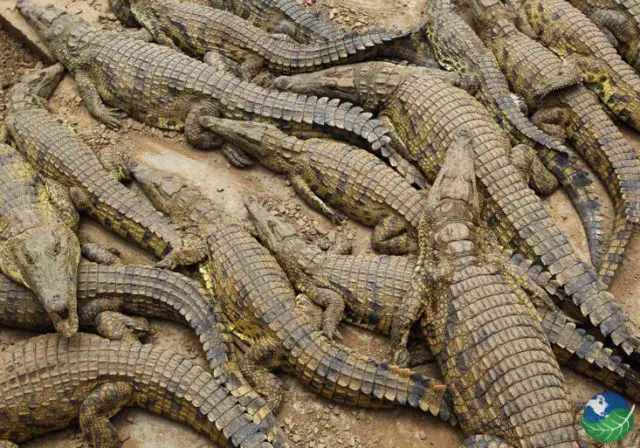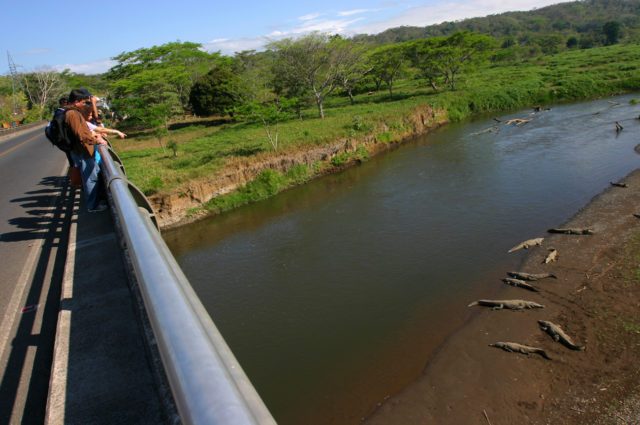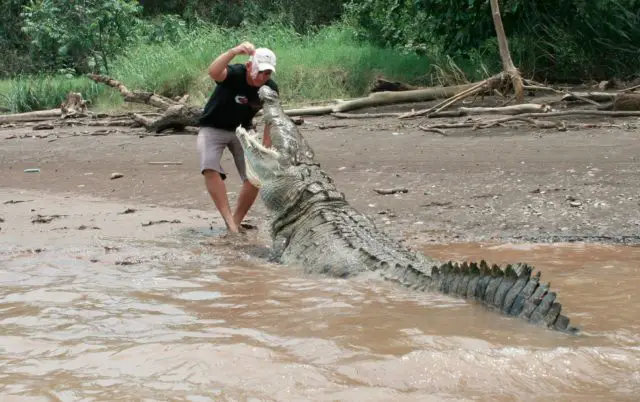Costa Rica’s biodiversity is remarkable, especially for such a tiny country. More than 500,000 species of flora and fauna are packed within its 51,100 km2 of territory. One of them is the crocodile.
These ancient reptiles, that outlived the dinosaurs, inhabit the tropics of Australia, Africa, the Americas, and Asia. The species has been reported in 17 countries of the region. Costa Rica is home to one of the world’s biggest populations of American crocodiles (Crocodylus acutus).

9 Croc facts
- There are 14 species of true crocodiles in the world.
- The American crocodile is one of the only 2 species to commonly live and even prosper in salt water. The other is the saltwater crocodile (Crocodylus porosus).
- Crocodylus Acutus are large animals. They are not common, but some mature males can reach almost 6 meters (19 feet) in length and weight up to 1,000 kilograms (2,200 pounds).
- Due to their metabolism, crocodiles can spend long periods of time between meals and up to 2 hours without breathing.
- A feature they share with other reptiles is that the sex of the crocodile is determined by the nest’s temperature during incubation.
- In order to control buoyancy, and to aid in digestion, crocodiles swallow stones.
- In the past, the species has suffered overexploitation and habitat loss. Nowadays, Crocodylus acutus is a protected species.
- Although not so aggressive as other species, Crocodylus Acutus may attack if threatened, disturbed, or taken by surprise.
- Some species have even killed and consumed humans. Specifically, 2 of the species with more attacks reported are the Australian and African varieties, respectively.
Tourism and crocodiles
Tico crocs inhabit several national parks: Santa Rosa National Park, Carara National Park, Corcovado National Park, Cañas, Tortuguero, Taboga and the Tárcoles River near the Pacific coast. Many countries like Australia, Thailand, India, and China, to name a few, take advantage of their croc populations to boost their tourist trade. Costa Rica is no exception. People just love to see these apex predators going about their business.
“Bridge Over Troubled Waters”
A well-known spot for croc watching is the bridge over Río Tárcoles. It is on the Pacific side of the country and it is hard to miss. You have to cross it on your way to Jaco or Manuel Antonio. Additionally, several tour operators offer croc safaris or river tours to see the “cocodrilos” in Tárcoles. The animals congregate near the bridge in large groups, to bask in the sun or to be fed by visitors. And that is when things get complicated.

In order to entertain the tourists, some tour operators and shop owners feed the crocodiles from the bridge and from the boats. This totally illegal practice is called baiting. It has an effect on the crocodiles; after a while, it modifies the animals’ behavior. When they start associating people with food, animals in general, lose their natural instinct of being scared around humans and can become very aggressive.
As all crocodiles are carnivorous, they are potentially dangerous to people. The ones in the Tárcoles have proven so several times and attacks and deaths of humans have happened.
To make things worse, the incidents do not circumscribe to the Tárcoles. Costa Rican beaches are among the favorites of surfers from all around the world. On many of those beaches, crocs and surfers have had many nasty encounters. A couple years ago, a surfer lost part of his leg on Tamarindo. The attack was widely reported and tourism, a huge job generator in Costa Rica, has been affected for that reason.

On the other hand, Río Tárcoles is not the best of places to take a dip. Not only because of the huge reptiles, but because of pollution. The river has been dubbed “the most polluted river in Costa Rica”. It drains most of the San José metropolitan area. Contaminants, like agrochemicals, raw sewage, and fecal matter, come from the commercial activities in the urban area as well as from the farms and industries along its course.
The river also carries lots of trash like bottles, appliances, mattresses, tires, and plastics all the way from San José to the sea. Studies indicate that this situation is having negative effects, not only on the river’s health but on the crocodiles’ as well.
Solutions
Apparently, there is none in sight yet. Although experts from the Sistema Nacional de Áreas de Conservación (SINAC), the public body in charge of studying, monitoring, and controlling wildlife, are conducting studies to determine what to do, everything indicates that the growing interaction between humans and crocodiles is the main cause of the attacks. Meanwhile, several measures are being taken to face the croc issue.
- Culling the crocodile population and/or relocating the most aggressive animals. These measures have been tried before with a varying degree of success, not only in Costa Rica but in many other places where wildlife and human beings clash.
- The least favored measure is to set limits to the human activities that affect the crocodiles’ habitats. It is easier said than done. Educating the public is the best bet as we tend to believe we have the preeminence in everything and do not respect wildlife.
A serious mistake, especially when you mess around with powerful animals like these, could easily cost your life and limb. It is necessary to understand that once we enter the crocodiles’ domain, we become part of the food chain.

